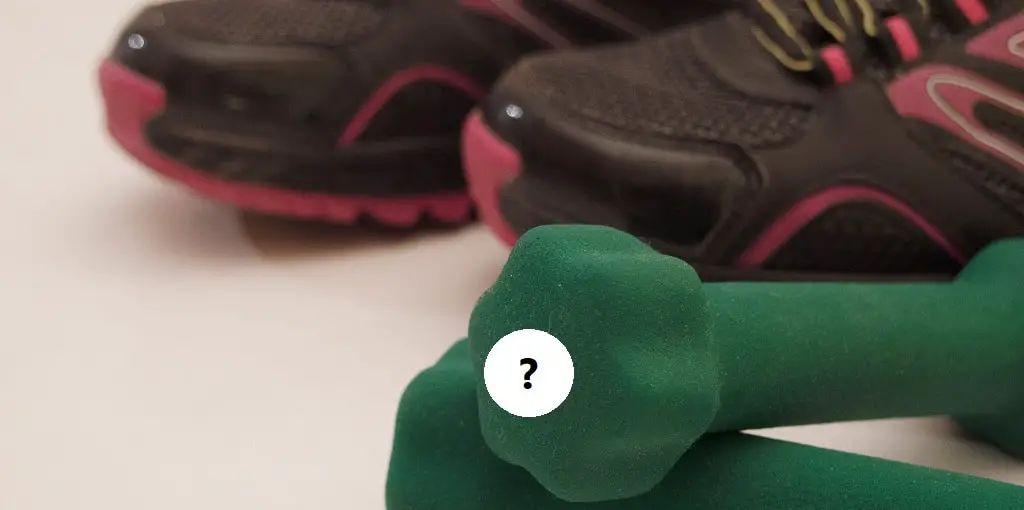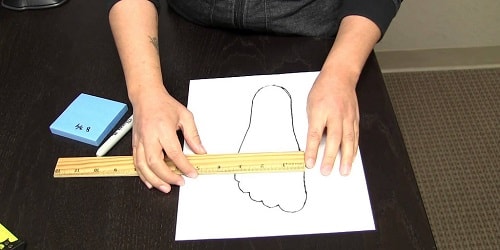When we prepare for our next camping or hiking adventure, we start to calculate each pound so that we don’t carry substantial weight. Personally, there were times in which I had to decide whether or not to bring my sleeping bag carrying sack – sometimes it seems like an unnecessary burden. While we are so focused on our backpack, we sometimes underestimate the importance of our hiking boots weight. So how much do hiking boots weigh on average and what difference could there possibly be when choosing ones which are a little more substantial? Well, let’s dive into it.

On average, hiking boots weigh around 2 pounds (approximately 907 g) – the weight differs between men and women and is mostly affected by the outsole.
For the calculation, I randomly gathered 30 pairs, checked their weight through reliable sources and calculated the average value.
How accurate is that number and what impact does it have on our back? I will try to answer these questions, and a few more, later on in this article.
Hiking Boots Average Weight
Basically, it is impossible to know the exact average weight of hiking boots. The reason for it is that one has to measure the value of all the boots in the world, sum their weight and divide it by the number of products he had collected.
Nevertheless, to get an estimated evaluation, I’ve decided to gather randomly 30 boots and measure their average weight. I took the data from reliable sources; RIE, the brands’ official sites and Amazon (excluding the weight of the shipping package itself).
To reduce the chance of gender bias, I’ve collected the boots in a way half of them are men’s (left section) and half are women’s (right section). I will present you the weight for each boot in grams, and make a conversion to pounds after the following table.
| Boot’s Name (Men’s) | Weight (g) | Boot’s Name (Women’s) | Weight (g) |
| Salomon Men’s X Ultra 3 Mid GTX | 895 | Salomon Women’s Quest Prime GTX | 935 |
| Merrell Men’s Moab 2 Mid | 963 | Salomon Women’s X Ultra 3 Mid | 833 |
| KEEN Men’s Gypsum II Mid | 1080 | Salomon Women’s Quest 4d 3 GTX | 1048 |
| Salomon Men’s X Ultra 3 GTX | 895 | Salomon Women’s Quest 4D 2 GTX | 1020 |
| Salomon Men’s X Ultra Mid 2 GTX | 963 | Salomon Women’s X Ultra Mid Aero | 720 |
| Salomon Men’s Quest 4D 2 GTX | 1020 | Salomon Women’s Authentic LTR | 907 |
| Salomon Men’s Authentic LTR GTX | 907 | KEEN Women’s Voyageur Mid | 779 |
| Merrell Men’s Moab FST MID GTX | 878 | KEEN Women’s Targhee II Mid WP-w | 805 |
| Merrell Men’s Moab 2 Vent Mid | 963 | KEEN Women’s Revel III | 907 |
| KEEN – Men’s Durand Waterproof Mid | 1133 | KEEN Women’s Koven Mid | 793 |
| Columbia Men’s Peakfreak Venture MID | 907 | Keen Women’s Gypsum Ii Mid | 901 |
| KEEN Men’s Targhee II Mid Wide | 986 | Columbia Women’s Newton Ridge | 760 |
| Columbia Men’s Redmond MID | 802 | Merrell Women’s Capra Bolt Mid | 680 |
| Columbia Men’s Newton Ridge Plus II | 912 | Merrell Women’s Moab FST Mid | 737 |
| KEEN Men’s Revel III Hiking Boot | 1150 | SCARPA Women’s R-Evolution GTX | 1080 |
As you can see, I’ve decided to focus on five leading brands, which are among the most popular on the market; Salomon, Merrell, KEEN, Columbia, and SCARPA.
The thought behind it was that the more known the brand is, the more high-quality and low-weight its hiking boots would be.
On average, the thirty boots weigh 911.8 grams which are approximately 2.01 pounds. That number represents the weight of the two boots (i.e., one pair) – let me tell you why that is crucial.
Many times we are going through products’ descriptions, we read what the manufacturer deliberately points us to. For example, the weight description of hiking boots and shoes is many times right; however, it shows how much a single boot or shoe weighs.
By doing so, the manufacturer many times leads us into thinking that the boot actually weighs less than it is, although we all know that the desired value is how much both boots weigh as a PAIR.
So we got the number 911.8 grams (2.01 pounds) – what does it really tell us? Well, not much, since as I’ve said above – it is impossible to measure the average weight of all the hiking boots.
However, that number could give you a general estimation for what you should look for when you’re buying a new pair of boots. If those which you’ve been thinking of are much heavier than 2 pounds, perhaps they are above average, and you should look for lighter ones.
Will 1-2 Pounds Make Any Difference?
So you’ve seen the numbers – some boots weight around 2 pounds while some of them even reach a fantastic value of 1 pound.
When brands invest millions of dollars in footwear to turn them as light as possible, it automatically pop-up a question – is it actually worth it? Will one pound or two make any difference at all?
Well, the answer is yes, and I have no doubt the enormous significance of this will surprise you; according to a study, which was conducted in 1984 by the U.S. Army Research Institute, each pound on your feet equals to 5 pounds on your back.

The researchers tested how much more energy the soldiers wasted when they hiked in heavy footwear. The results were shocking.
Apparently, it takes 4.7 to 6.4 times as much power to move a permanent distance when the weight is on your feet instead of on your torso.
To get a better understanding on how important that is, take the following example; if you buy a new pair of boots, which are one pound lighter than your old ones, you will be able to carry a half water gallon more and waste the same amount of energy as you used to (one gallon equals to approximately 4 pounds).
If you ask me – that makes a huge difference when hiking long distances, especially when you also plan on camping.
That course of thoughts also brings us to the conclusion that you will waste 5% less energy for each pound you reduce, which will allow you to hike longer distances at a faster pace.
What Mainly Makes Them Heavy?
The main ingredient that makes hiking boots heavy is their outsole, which is usually a thick rubber that supposed to absorb shocks and maintain traction.
So why not reducing that weight in half by cutting the outsole width? Haven’t we already realized that each pound matters? After all, the primary purpose of these boots is hiking long distances in extreme conditions.
Well, besides weight, you should take some other things into considerations when thinking about the ideal boot. You would also like your footwear to be durable and to feature a long lifespan.
When the outsole is relatively thick, it would be able to endure harsh ground conditions so your feet wouldn’t be straining much. Another factor in the equation is ankles support – the ticker and stiffer your boots, the more your ankle would be secured.
If you’ve experienced ankles pains, that might be because your hiking boots are too supportive. In fact, I’ve dedicated a whole article to that issue; going through all the reasons why your ankles might sore and providing you with all the possible solutions for the problem.
Is There a Difference Between Men’s & Women’s?
When buying a new pair of shoes, we usually do not doubt the differences between men’s and women’s. Although the main difference that pops to mind is the color of the boots – perhaps women’s would feature bright ones, sometimes even pink and yellow.
But what about the weight? Is there any difference between the two?
The answer is yes – men’s hiking boots usually weigh more than women’s. There are many variables in the equation and to say precisely why may be difficult.
Nevertheless, the most apparent factor that distinguishes the two types is the last they feature. Men’s hiking footwear is usually made of a larger and wide one, to ensure a better fit for male foot (in opposed to women’s).
Remember the table I showed you early on? Well, comparing only fifteen pairs of men and women hiking boots wouldn’t be a representative sample, although you can see the differences even there – the average weight in the men’s section was 963.6 g (2.12 pounds) while it was only 860.03 g (1.89 pounds) in the women’s.
Are Modern Hiking Boots Lighter Than Old Ones?
As a person who hiked both in modern boots and the horrible Alpine style, full leather boots – there is no doubt the modern ones perform better regarding weight.
As I’ve researched the reasons for that, I understood that the combination of synthetic materials with leather is what provides nowadays boots their lightness.
On the other hand, old boots are usually full-leather, which is much more substantial and features poor ventilation. There are, exceptions to both sides, although through my experience I was able to verdict in favor of modern boots.
Still, you should take other factors into account, since full synthetic boots would be lightweight, although they wouldn’t be as much as water-resistant as leather.
Going Light vs. Heavy
By now we’ve seen how significant hiking boots weight could be concerning energy consumption and back burden. It is quite intuitive to think that a lightweight pair would be better than a heavy one, however, as you will see – sometimes it is better to keep things heavy.
On that matter, if you consider buying lightweight hiking boots, please read my article which discusses the top on the market according to 2018 reviews and personal experience. I’ve spent three working days to provide you with the most beneficial data, so you get the most accurate picture.
Terrain Conditions
When you are hiking in harsh conditions, climbing mountains or walk long distances – it is better to go with a massive pair that would absorb shocks and make things easier for your feet.
On the other hand, if you are satisfied with merely day hikes on moderate, plane terrain – there is no point to exaggerate, and lightweight boots would probably work on your benefit.
The Weight of Your Backpack
This factor contradicts the previous one a little since longer hikes usually require a more massive backpack, although I would recommend that you keep your boots lightweight in a case there is a significant burden on your back.
The reason for this is the previous study which showed that lighter footwear would allow you to endure higher weight torso carrying. In general, if you are hiking long distances, keep your backpack as light as possible along with your boots.
Ankle Twisting
If you are facing some inclines on your hike, there is a good chance for an ankle abrasion and twisting. Well, bulkier boots usually feature better ankle support in opposed to low cut hiking boots, which are generally lighter.
When hiking mountains – stick to a more robust pair with a better secure around your ankles – a twisted ankle would most probably end your trip, and you should do anything you can to avoid that from happening.
Can The Weight be Related to Toes or Ankle Pains?
By intuition, the more stiff and heavyweight the hiking boots are, is it more likely they will cause pains across your feet.
Regarding ankle pains – this is partially true since heavy boots usually feature proper ankle support, and too much of it might cause injuries in the ankles areas.
I’m not talking about the pain which is the result of twisting your feet – that is an entirely different story, and ankle support should prevent this.
On the contrary, I am referring to pains which develop as you hike longer and become most substantial towards the end of your walk.
Regarding toes pain – the most common reason for that is when there is not enough room in the toe box area. There is no direct correlation between that gap and the weight of the boots – although stiff boots might feature a narrow toe box which might not work for everyone.

On that matter, when you are choosing a new pair, try walking around with it and see if any discomfort appears. In general, you should keep ½ an inch between your toes and the boots so that you can bend your toes freely inside.
If you’ve been experiencing pains around your toes while hiking in your boots, please read my article which discusses that issue. In there, I’ve collected you all the reasons I could possibly find for the problem and offered several solutions based on my experience.
Conclusions
On average, hiking boots should weight around 2 pounds. It’s hard to tell the exact number since it is impossible to take into account all the pairs in the world.
For that reason, I’ve decided to focus on 30 pairs which were made by the world’s leading brands. From a general perspective, the differences in hiking boots weight may seem insignificant.
Nevertheless, studies showed that it does have an impact – perhaps each pound you add to your footwear equals to five pounds in your backpack.
On the contrary, there are cases in which heavy boots may be a better choice – hiking in harsh conditions and inclines, for example.
Boots weight also play a role in women’s and men’s sections. In opposed to women’s, men’s hiking boots are usually more massive; although the impact of this difference is questionable and is relatively small.
I hope my article had answered your question or at least pointed you in the right direction. If you have any hesitations or new insights – let me know all about them by leaving a comment below!

